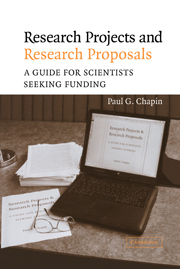Book contents
- Frontmatter
- Contents
- Foreword
- Acknowledgments
- Introduction
- 1 Selecting a Research Topic
- 2 Project Planning
- 3 Identifying Funding Sources
- 4 Special Funding Mechanisms
- 5 Writing a Proposal
- 6 Research Ethics and Responsibilities
- 7 The Natural History of a Proposal
- 8 “We Are Happy/Sorry to Inform You …”
- 9 Managing Your Grant
- Appendix A Glossary of Acronyms
- Appendix B Useful URLs
- Index
3 - Identifying Funding Sources
Published online by Cambridge University Press: 14 July 2009
- Frontmatter
- Contents
- Foreword
- Acknowledgments
- Introduction
- 1 Selecting a Research Topic
- 2 Project Planning
- 3 Identifying Funding Sources
- 4 Special Funding Mechanisms
- 5 Writing a Proposal
- 6 Research Ethics and Responsibilities
- 7 The Natural History of a Proposal
- 8 “We Are Happy/Sorry to Inform You …”
- 9 Managing Your Grant
- Appendix A Glossary of Acronyms
- Appendix B Useful URLs
- Index
Summary
When the research plan is well developed enough that it is time to start thinking about preparing a proposal, the first step is to decide where to submit it. That decision will significantly affect how you write the proposal, and is itself significantly constrained by the nature and scope of the research you are planning. The purpose of this chapter is to give you some practical guidance in deciding where to seek funding for your research.
U.S. Government Agencies – Missions and Methods
Since discovering in World War II how scientific knowledge could bestow military advantage, the U.S. Government has been the largest single supporter of scientific research in the world. Through its own laboratories and think tanks, and through grants and contracts to scientists based in universities and other research institutions, the U.S. Government has invested hundreds of billions of dollars in basic and applied research across the full spectrum of scientific disciplines. The government's commitment to this support has been largely free of partisan political dispute, and has continued uninterrupted through numerous changes of administration and political control of Congress. Thus any American scientist seeking research funding from outside the walls of his or her own institution has to at least consider the possibility of applying to the federal government for it.
To call the U.S. Government a “single” supporter of research, as we just did, is accurate in the sense of contrasting it with the panoply of universities, industrial laboratories, and private research labs, which collectively provide more research support from their own resources than the federal government does, although no single institution equals it.
- Type
- Chapter
- Information
- Research Projects and Research ProposalsA Guide for Scientists Seeking Funding, pp. 24 - 42Publisher: Cambridge University PressPrint publication year: 2004



